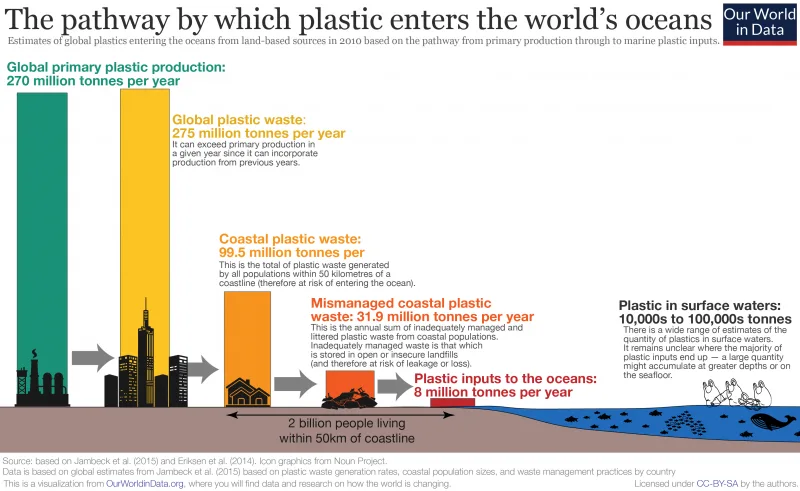by Hannah Ritchie and Max Roser
 Global plastic pollution refers to the widespread presence and accumulation of plastic waste in various ecosystems around the world, particularly in our oceans and landfills. It is a significant environmental issue that poses threats to marine life, ecosystems, and human health. Plastic pollution occurs when plastic products, such as single-use plastics, are improperly disposed of and end up in natural environments, where they take hundreds of years to decompose. This pollution has detrimental effects on wildlife, as animals can mistake plastic for food or become entangled in it. It also contributes to the degradation of ecosystems and can leach harmful chemicals into the environment. Addressing global plastic pollution requires a collective effort to reduce plastic consumption, improve waste management systems, and promote the use of sustainable alternatives.
Global plastic pollution refers to the widespread presence and accumulation of plastic waste in various ecosystems around the world, particularly in our oceans and landfills. It is a significant environmental issue that poses threats to marine life, ecosystems, and human health. Plastic pollution occurs when plastic products, such as single-use plastics, are improperly disposed of and end up in natural environments, where they take hundreds of years to decompose. This pollution has detrimental effects on wildlife, as animals can mistake plastic for food or become entangled in it. It also contributes to the degradation of ecosystems and can leach harmful chemicals into the environment. Addressing global plastic pollution requires a collective effort to reduce plastic consumption, improve waste management systems, and promote the use of sustainable alternatives.
How much plastic enters the world’s oceans?

To understand the magnitude of input of plastics to the natural environment and the world’s oceans, we must understand various elements of the plastic production, distribution and waste management chain. This is crucial, not only in understanding the scale of the problem but in implementing the most effective interventions for reduction.
The data and visualizations which follow in this entry provide this overview step-by-step. This overview is summarized in the figure.1
Here we see that in 2010:
- global primary production of plastic was 270 million tonnes;
- global plastic waste was 275 million tonnes – it did exceed annual primary production through wastage of plastic from previous years;
- plastic waste generated in coastal regions is most at risk of entering the oceans; in 2010 coastal plastic waste – generated within 50 kilometres of the coastline – amounted to 99.5 million tonnes;
- only plastic waste which is improperly managed (mismanaged) is at significant risk of leakage to the environment; in 2010 this amounted to 31.9 million tonnes;
- of this, 8 million tonnes – 3% of global annual plastics waste – entered the ocean (through multiple outlets, including rivers);
- Plastics in the oceans’ surface waters is several orders of magnitude lower than annual ocean plastic inputs. This discrepancy is known as the ‘missing plastic problem’ and is discussed here.
- The amount of plastic in surface waters is not very well known: estimates range from 10,000s to 100,000s tonnes.
How much plastic does the world produce?
The chart shows the increase of global plastic production, measured in tonnes per year, from 1950 onwards.
In 1950 the world produced only 2 million tonnes per year. Since then, annual production has increased nearly 230-fold, reaching 460 million tonnes in 2019.
The short downturn in annual production in 2009 and 2010 was predominantly the result of the 2008 global financial crisis — a similar dent is seen across several metrics of resource production and consumption, including energy.
Leave a Reply